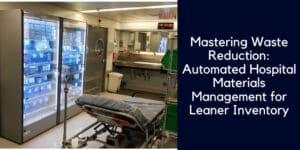What’s inside:
Healthcare supply chains are facing constant change and unprecedented challenges.
This blog explores how leveraging supply chain data can transform your healthcare organization.
We focus on OR, known as a difficult data collection point, and discover how to:
- Build a more resilient supply chain
- Achieve demand-driven inventory management
- Leverage AI to achieve supply chain optimization
- Improve data quality for smarter insights
Today’s healthcare leaders are expected to navigate spikes in demand, rapid growth, and catastrophic events – all while reducing costs and optimizing the quality of care. supply chain data
It’s a complex task, and in this volatile environment a robust supply chain is no longer just a cost-saving measure, it’s a strategic imperative.
Since the COVID 19 epidemic, healthcare providers have been keen to minimize risk and bolster resilience, but funding a surplus of safety stock simply isn’t smart, particularly during these cost-cautious times.
Instead, providers are looking to gain clear vision of their enterprise-wide inventory and understand demand trends, so that they can better anticipate their future needs and focus funding with greater precision.
As the healthcare sector adjusts to its new normal, supply chain data has become a vital commodity.
So, let’s take a look at the role of supply chain data in reducing risk and boosting resilience.
The Value of Supply Chain Data in Healthcare Management
Accurate and timely data collection is the cornerstone of effective inventory management in healthcare.
Business intelligence acts as an early warning system, empowering providers to anticipate and mitigate potential disruptions.
To harness the full potential of supply chain data, organizations must excel in two critical areas: the collection of raw data, and the generation of data analytics.
When these elements are optimized, healthcare providers can gain unprecedented visibility into their inventory, enabling precise demand forecasting and informed resource allocation.
Supply Chain Data Quality
AI insights are the driving force of modern healthcare management, but their value is dependent on the quality of the raw data used in their analysis.
As healthcare organizations look to improve their supply chain resilience, compromised data is producing unreliable insights leading to flawed decisions. This phenomenon, can be simply summarized as “garbage in, garbage out.”
So, it’s not surprising that smart providers are focusing on fortifying their data foundations as they work towards a data-driven supply chain.
Everyone’s talking about insights and analytics, but the real star of the show is often overlooked – it’s raw data that’s the unsung hero.
High-quality data is the bedrock upon which meaningful analytics are built. Every analytical process and AI application hinges on the accuracy, completeness, and timeliness of its source data.
As we engage with healthcare providers about their data collection capabilities, it becomes evident that they face significant challenges in collecting high-quality inventory data, especially within the complex surgical setting.
Using AI technology for supply chain management
AI technology is transforming data collection and processing, as well as delivering razor sharp analytics.
Data collection:
New AI-vision technology is powering point-of-use supply documentation, achieving full, real-time supply utilization records before the end of surgery.
This accelerated documentation relies on several advanced technologies:
- Computer vision uses camera technology to record the products used in surgery, then converts the image into digital data.
- Machine learning algorithms check the correctness and completeness of data, tapping into a cloud data lake to identify, verify and validate each product.
- AI fixes any missing or bad data, ensuring comprehensive product details, including full UDI, are documented in the system.
AI, computer vision and machine learning are simplifying and streamlining perioperative documentation, while optimizing data quality.
Once full and accurate data is collected at the point of use, it has organization-wide value, feeding into the fundamental workflows that drive efficient hospital operations, administration, and healthcare delivery.

Data analytics:
The integration of AI into supply chain management goes beyond data collection. By providing real-time insights into inventory levels and usage patterns, AI empowers healthcare organizations to make data-driven decisions that improve efficiency, reduce costs, and enhance patient care.
- Machine learning algorithms can identify opportunities for supply chain optimization, highlighting areas of inefficiency or risk, and supporting value analysis, cost-reduction and revenue optimization initiatives.
- Predictive analytics analyses vast amounts historical data on product usage, patient demographics, the surgical schedule and more., plus takes account of external factors. It can pick up on subtle trends that humans tend to miss and can make sophisticated demand forecasts that help to providers to balance supply with predicted fluctuations in demand.
High level business intelligence informs inventory decision-support processes, helping providers to work smarter.
The ROI of Supply Chain Data
When healthcare facilities achieve supply chain efficiency, the financial impact is significant, saving millions of dollars:
🔽 Reduction in excess inventory by 20-30%
🔽 Reduction in the number of expired items in stock down to zero
🔽 Reduction in expiry wastage averages 70%
🔼 Increase in reimbursement by 10-30%.
There are clinical, operational and business benefits to optimizing supply chain data.
Leveraging AI supply chain solutions in tricky data-collection locations, like operating rooms and procedural areas, will deliver high-quality insights for smarter healthcare management.
Contact us to request a chat if you want to find out about using AI technology to boost your data collection capabilities and optimize your supply chain: Link






